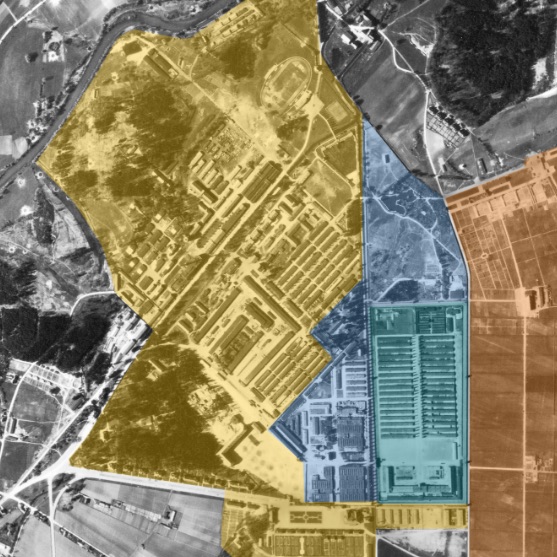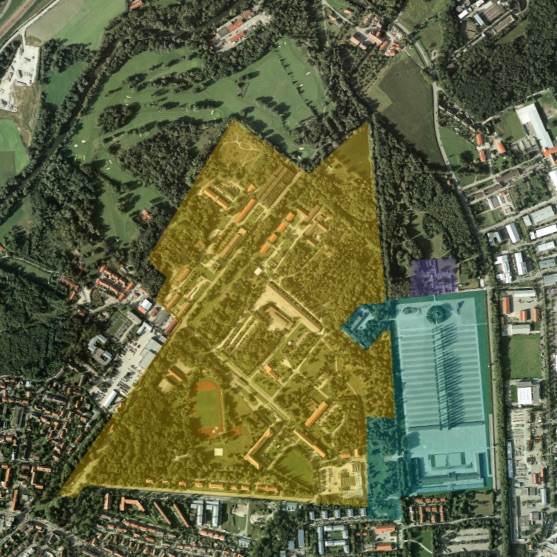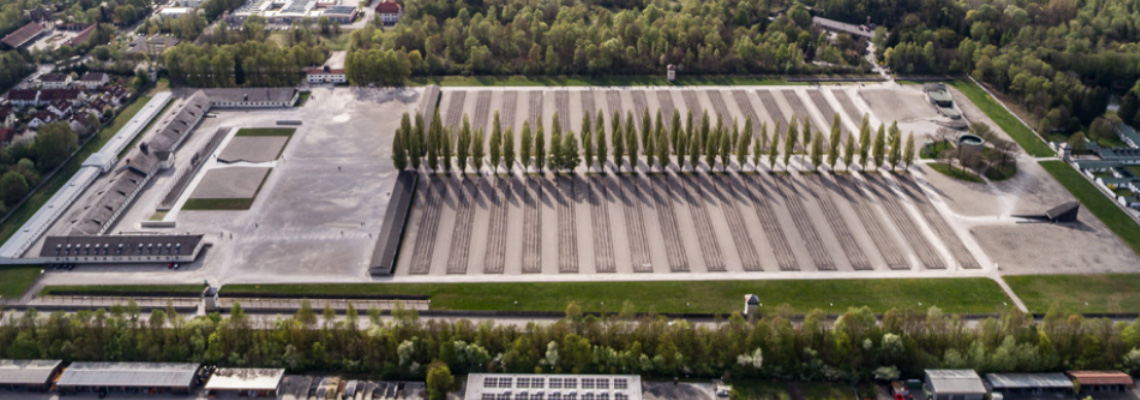Topographical Positions
As a comparison of the two aerial photographs from 1945 and 2006 shows, the Memorial Site does not exactly cover the geographical expanse and structural makeup of the concentration camp. After the war, a diverse variety of reuses reshaped and changed the grounds and its building structures. Numerous historical structures were modified, demolished, or destroyed. In some cases only traces and relicts remain.
The development of the grounds into the Dachau Concentration Memorial Site, opened in 1965, followed the principles advocated by the involved survivors, to renovate and preserve the historical building substance considered especially relevant and significant for representing the suffering of the prisoners. Other building remnants were deliberately removed.
Today, the physical remains of the camp’s grounds serve as the starting point for presenting the historical repercussions of the politics of persecution and extermination pursued by the Nazi regime. The methodological guideline for developing and arranging the grounds is to secure the relicts and mark them as such. Subsequent reshaping and changing is identified and marked as an added historical layer.
As a place of learning and critical discussion about the history of National Socialism, the Memorial Site has the character of a museum. Exhibitions in the historical buildings meet this task, while in outdoor areas information panels provide orientation for visitors.
Numerous monuments, memorial stones, commemorative plaques, and gravesites are also located on the grounds. As a place of remembrance for the victims of the Nazi regime, the Memorial Site has a particularly important and significant role to play in international commemorative culture.
 Aerial shot of the Dachau concentration camp, April 20 1945
Aerial shot of the Dachau concentration camp, April 20 1945 This aerial photograph shows the Dachau concentration camp on April 20 1945. The color markings highlight sections of the concentration camp, each of which fulfilled different functions.
The green area covers the prisoner camp. The 34 symmetrically arranged barracks are clearly visible. Prisoners were quartered in 30 of them.
The orange area marks agricultural land the SS euphemistically called the “herb garden”. The area was part of the “Deutsche Versuchsanstalt für Ernährung und Verpflegung GmbH” (DVA), an institute established by the SS for the purpose of cultivating and researching medicinal plants. From 1938 onwards, prisoners carried out forced labor here. Due to the brutal working conditions enforced to cultivate the land, the prisoners named it the “plantation”.
The area of the commandant’s headquarters of the camp SS is marked blue. Located here were the offices of the camp commandant, the quarters of the SS men assigned to guard the prisoners, as well as the crematorium area.
The yellow area is the SS training camp. Here SS men were indoctrinated ideologically and drilled militarily. Also located in this area were administrative, residential, and various storage buildings as well as workshops in which concentration camp prisoners were forced to work. Towards the end of the war, the grounds of the Dachau concentration camp covered more than two square kilometers.
 Aerial shot of the Dachau Concentration Camp Memorial Site, September 13 2006
Aerial shot of the Dachau Concentration Camp Memorial Site, September 13 2006This aerial photograph shows the grounds of the former Dachau concentration camp in 2006. The area of the Dachau Concentration Camp Memorial Site is marked green. The Memorial Site covers the area of the former prisoner camp, the crematorium grounds, and other smaller sections of the former commandant’s headquarters. Also located in the latter and marked purple is the Carmelite Convent.
On a large part of the former concentration camp, once the grounds of the SS, are buildings and facilities of the Bavarian Riot Police. The marked yellow area is separated from the Memorial Site by a fence and not accessible to the public. After the war, the American military government used the former SS area as an internment camp and garrison base. In 1972, the Bavarian state government took over the area and based a division of the Bavarian Riot Police there.
The grounds of the former SS experimental agriculture facility/”herb garden” is today largely overbuilt with commercial and industrial firms, but the main ensemble of buildings remains. Today it is owned by the City of Dachau.

